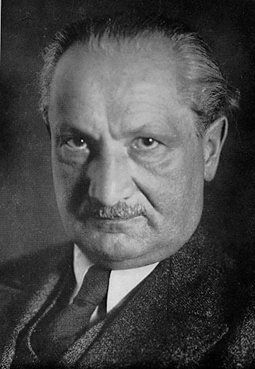

读马丁·海德格尔《筑 居 思》
雷颖
筑 居 思
马丁·海德格尔
In what follows we shall try to think about dwelling and building. This thinking about building does not presume to discover architectural ideas, let alone to give rules for building. This venture in thought does not view building as an art or as a technique of construction; rather it traces building back into that domain to which everything that is belongs. We ask:
What is it to dwell?
How does building belong to dwelling
在下文中,我们将试图思考栖居与筑造。这种关于筑造的思考并不是要去发现建筑的理念,更不是去制定建筑的规则。这种思想冒险并不认为筑造是一种艺术或一种建造技术;而是把筑造追溯到一切事物所属的领域。我们设问:
1.什么是栖居?
2.筑造在什么情况下属于栖居?
Ⅰ
We attain to dwelling, so it seems, only by means of building. The latter, building, has the former, dwelling, as its goal. Still, not every building is a dwelling. Bridges and hangars, stadiums and power stations are buildings but not dwellings; railway stations and highways, dams and market halls are built, but they are not dwelling places. Even so, these buildings are in the domain of our dwelling. That domain extends over these buildings and yet is not limited to the dwelling place. The truck driver is at home on the highway, but he does not have his shelter there; the working woman is at home in the spinning mill, but does not have her dwelling place there; thechief engineer is at home in the power station, but he does not dwell there. These buildings house man. He inhabits them and yet does not dwell in them, when to dwell means merely that we take shelter in them.In today’s housing shortage even this much is reassuring and to the good; residential buildings do indeed provide shelter; today’s houses may even be well planned, easy to keep, attractively cheap, open to air, light, and sun, but—do the houses in themselves hold any guarantee that dwelling occurs in them? Yet those buildings that are not dwelling places remain in turn determined by dwelling insofar as they serve man’s dwelling. Thus dwelling would in any case be the end that presides over all building. Dwelling and building are related as end and means. However, as long as this is all we have in mind, we take dwelling and building as two separate activities, an idea that has something correct in it. Yet at the same time by the means-end schema we block our view of the essential relations. For building is not merely a means and a way toward dwelling—to build is in itself already to dwell. Who tells us this? Who gives us a standard at all by which we can take the measure of the nature of dwelling and building?
看起来,我们只能通过筑造来达到栖居的目的。筑造以栖居为目的。然而,并非每一栋建筑都是居所。桥梁和候机室、体育场和发电站是建筑物,但不是居所;修建了火车站、高速公路、水坝和商场,但它们不是居住的地方。即便如此,这些建筑还是属于我们栖居的领域。该领域超出了这些建筑物,但并不限于居住场所。卡车司机以高速公路为家,但在这里没有居所;女工以纺织厂为家,但在这里没有住处;总工程师以发电站为家,但他不在那里居住。这些建筑物给人们提供了住处。当“栖居”仅仅意味着我们占用某个住宿地时,人们身处其中,但不在这里居住。在当今住房短缺的情况下,占用某个住宿地是令人安心和有益的;住宅建筑确实提供了庇护;如今的房屋甚至可能有良好的布局,易于维护,价格便宜,通风良好,光线充足,阳光充裕,但是——这些房屋本身能保证栖居的发生吗?然而,那些不是居住场所的建筑,只要它们服务于人类的栖居,就仍然由栖居决定。因此,栖居在任何情况下都是支配一切筑造的目的。栖居与筑造是目的和手段的关系。然而,只要我们全然支持这种看法,我们就会把栖居和筑造看作是两种分离的活动,从中表现出某些正确的东西。但同时,我们通过目的—手段的模式,阻挡了我们对本质关系的看法。因为筑造不只是获得栖居的手段和方式——筑造本身就已经是栖居。谁能告诉我们这一点呢?谁能给我们一个标准,使我们能够衡量栖居和筑造的本质?
It is language that tells us about the nature of a thing, provided that we respect language’s own nature. In the meantime, to be sure, there rages round the earth an unbridled yet clever talking, writing, and broadcasting of spoken words. Man acts as though he were the shaper and master of language, while in fact language remains the master of man. Perhaps it is before all else man’s subversion of this relation of dominance that drives his nature into alienation. That we retain a concern for care in speaking is all to the good, but it is of no help to us as long as language still serves us even then only as a means of expression. Among all the appeals that we human beings, on our part, can help to be voiced, language is the highest and everywhere the first.
只要我们尊重语言的本性,语言则告诉我们事物的本质。同时,毫无疑问,在全球到处是放纵却又圆滑的有关言说的谈话、写作和广播。人的行为看似是语言的塑造者和主人,而实际上语言是人的主人。也许是人类对这种支配关系的颠覆,驱使他的本性走向异化。我们在说话时注重细心,这是有益的,但只要语言仍然只作为一种表达方式为我们服务,这种注重对我们是无济于事的。在我们人类能够帮助表达的所有呼吁中,语言是最高的,在任何地方都是第一位的。
What, then, does Bauen, building, mean? The Old English and High German word for building, buan, means to dwell. This signifies: to remain, to stay in a place. The real meaning of the verb bauen, namely, to dwell, has been lost to us. But a covert trace of it has been preserved in the German word Nachbar, neighbor. The neighbor is in Old English the neahgebur; neah, near, and gebur, dweller. The Nachbar is the Nachgebur, the Nachgebauer, the near-dweller, he who dwells nearby. The verbs buri, büren, beuren, beuron, all signify dwelling, the abode, the place of dwelling. Now to be sure the old word buan not only tells us that bauen, to build, is really to dwell; it also gives us a clue as to how we think about the dwelling it signifies. When we speak of dwelling we usually think of an activity that man performs alongside many other activities. We work here and dwell there. We do not merely dwell—that would be virtual inactivity—we practice a profession, we do business, we travel and lodge on the way, now here, now there. Bauen originally means to dwell. Where the word bauen still speaks in its original sense it also says how far the nature of dwelling reaches. That is, bauen, buan, bhu, beo are our word bin in the versions: ich bin, I am, du bist, you are, the imperative form bis, be. What then does ich bin mean? The old word bauen, to which the bin belongs, answers: ich bin, du bist mean: I dwell, you dwell. The way in which you are and I am, the manner in which we humans are on the earth, is Buan, dwelling. To be a human being means to be on the earth as a mortal. It means to dwell. The old word bauen, which says that man is insofar as he dwells, this word bauen however also means at the same time to cherish and protect, to preserve and care for, specifically to till the soil, to cultivate the vine. Such building only takes care—it tends the growth that ripens into its fruit of its own accord. Building in the sense of preserving and nurturing is not making anything. Shipbuilding and temple-building, on the other hand, do in a certain way make their own works. Here building, in contrast with cultivating, is a constructing. Both modes of building—building as cultivating. Latin colere, cultura, and building as the raising up of edifices, aedificare— are comprised within genuine building, that is, dwelling. Building as dwelling, that is, as being on the earth, however, remains for man’s everyday experience that which is from the outset “habitual”—we inhabit it, as our language says so beautifully: it is the Gewohnte. For this reason it recedes behind the manifold ways in which dwelling is accomplished, the activities of cultivation and construction. These activities later claim the name of bauen, building, and with it the fact of building, exclusively for themselves. The real sense of bauen, namely dwelling, falls into oblivion.
那么,筑造是什么意思?古英语和高德语表示筑造的词buan,意味着栖居。这表明:要留下来,要待在一个地方。动词bauen即栖居的真正意义,对我们来说已经失落了。但在德语词Nachbar(邻居)中,还保留着一丝隐蔽的痕迹。“邻居”的古英语是neahgebur;neah即“附近”,gebur即“居民”。邻居就是“Nachgebur”、“Nachgebauer”,是在附近居住的人。动词buri,büren,beuren和 beuron,都表示居住、居住场所。现在,buan这个古词不仅告诉我们bauen筑造实际上就是栖居,而且同时也暗示我们如何来思考由此词所命名的栖居。当我们谈到栖居时,我们通常以为是一种行为,是人类在其他许多行为方式之外也在做的一种行为。我们在这里工作,在那里居住。我们不仅仅是居住——这近乎是无所事事——我们从事一种职业,我们做生意,我们旅行,在途中住宿,有时在这里,有时在那里。Bauen筑造最初的意思是栖居。“bauen”这个词的原义依然存在,它也说明了栖居的本质所及的范围。bauen,buan,bhu,beo是我们的单词bin的不同变换形式:ich bin我是,du bist你是,祈使形式bis和be。那么“我是ich bin”是什么意思呢?bin所属的古词bauen给出了答案:ich bin,du bist的意思是“我居住,你居住”。“你是”和“我是”的方式,即我们人类在大地上存在的方式,是Buan,即居住。作为人类在大地上终有一死,它意味着居住。古词bauen表示:就人居住而言,人存在,但这个词同时也意味着珍惜和保护、保存和照顾,比如耕种田地,养植葡萄。这种筑造只是守护着植物从自身中结出果实的生长。从保存和养育的意义上来说,筑造并不是制造。相反,造船业和寺庙建筑以某种方式制造出它们的作品本身。在这里,与保养相对,筑造是一种建设。作为保养的筑造(即拉丁语的colere,cultura)和作为建筑物的建立的筑造(即拉丁语的aedificare)——这两种筑造方式包含在真正的筑造即栖居中。但对于人类的日常经验来说,作为栖居的筑造,即在大地上存在,自始就是——正如我们的语言十分美好地说出的那样——“习以为常的东西”。因此,这种筑造便让路给栖居所实行的多样方式,让路给保养和建立活动。这些活动随后取得了筑造这个名称,并借此独占了筑造的事情。筑造的真正意义,即栖居,陷于被遗忘状态中了。
At first sight this event looks as though it were no more than a change of meaning of mere terms. In truth, however, something decisive is concealed in it, namely, dwelling is not experienced as man’s being; dwelling is never thought of as the basic character of human being.
乍一看,这件事情似乎只不过是词义的改变而已。然而事实上,它隐藏着某种决定性的东西,也就是说,栖居没有被经验为人的存在;栖居从来不被认为是人存在的基本特征。
That language in a way retracts the real meaning of the word bauen, which is dwelling, is evidence of the primal nature of these meanings; for with the essential words of language, their true meaning easily falls into oblivion in favor of foreground meanings. Man has hardly yet pondered the mystery of this process. Language withdraws from man its simple and high speech. But its primal cell does not thereby become incapable of speech; it merely falls silent. Man, though, fails to heed this silence.
语言在某种程度上收回了bauen栖居这个词的真正意义,但这证明了这些意义的原始性质;因为在语言的根本话语中,它们的真正意义很容易为了那些浅显的意思被遗忘。人类几乎没有考虑过这一过程的奥秘。语言从人那里收回了它的简单的和高级的言说,但它的原始细胞不会因此变得无法言说,它只是一声不响。然而,人类却不留意这种沉默。
But if we listen to what language says in the word bauen we hear three things:
但如果我们听到语言在bauen这个词中所说的话,我们就会听到以下三点
Building is really dwelling.
1.筑造是真正的栖居。
Dwelling is the manner in which mortals are on the earth.
2.栖居是终有一死的人在大地上存在的方式。
Building as dwelling unfolds into the building that cultivates growing things and the building that erects buildings.
3.作为栖居的筑造展开为那种保养生长的筑造与建立建筑物的筑造。
If we give thought to this threefold fact, we obtain a clue and note the following: as long as we do not bear in mind that all building is in itself a dwelling, we cannot even adequately ask, let alone properly decide, what the building of buildings might be in its nature. We do not dwell because we have built, but we build and have built because we dwell, that is, because we are dwellers. But in what does the nature of dwelling consist? Let us listen once more to what language says to us. The Old Saxon wuon, the Gothic wunian, like the old word bauen, mean to remain, to stay in a place. But the Gothic wunian says more distinctly how this remaining is experienced. Wunian means: to be at peace, to be brought to peace, to remain in peace. The word for peace, Friede, means the free, das Frye, and fry means: preserved from harm and danger, preserved from something, safeguarded. To free really means to spare. The sparing itself consists not only in the fact that we do not harm the one whom we spare. Real sparing is something positive and takes place when we leave something beforehand in its own nature, when we return it specifically to its being, when we “free” it in the real sense of the word into a preserve of peace. To dwell, to be set at peace, means to remain at peace within the free, the preserve, the free sphere that safeguards each thing in its nature. The fundamental character of dwelling is this sparing and preserving.
如果我们考虑到这三点,我们就会得到一种暗示并注意以下事情:只要我们不思索所有的筑造本身就是一种栖居,我们甚至不能充分地问,更不用说正确地决断——建筑物的筑造本质上是什么。我们栖居不是因为我们已经筑造了;而是我们筑造并且已经筑造了,是因为我们栖居,也即作为栖居者而存在。但栖居的本质是什么呢?我们再一次倾听语言对我们的言说。古萨克森语中的“wuon”和哥特语中的“wunian”,就像bauen这个古词一样,也意味着持留、逗留。而哥特语中的“wunian”更清楚地告诉我们应如何经验这种持留。Wunian意味着:满足,被带向和平,在和平中持留。和平Friede一词意指自由,即Frye,而fry一词意味着:防止损害和危险,“防止……”也就是保护。自由的真正意思是保护。保护本身不仅仅在于我们没有损害所保护的东西。真正的保护是某种积极的事情,它发生在我们事先保留某物的本质的时候,在我们特别地把某物隐回到它的本质之中的时候,按照字面来讲,也就是在我们使某物自由的时候。栖居,即被带向和平,意味着始终处于自由之中,这种自由把一切都保护在其本质之中。
It pervades dwelling in its whole range. That range reveals itself to us as soon as we reflect that human being consists in dwelling and, indeed, dwelling in the sense of the stay of mortals on the earth.
栖居的基本特征就是这样一种保护,它贯通栖居的整个范围。一旦我们考虑到,人的存在基于栖居,并且是作为终有一死者逗留在大地上,这时,栖居的整个范围就会向我们显示出来。
But “on the earth” already means “under the sky.” Both of these also mean “remaining before the divinities” and include a “belonging to men’s being with one another.” By a primal oneness the four—earth and sky, divinities and mortals—belong together in one.
但“在大地上”就意味着“在天空下”。两者都意味着“在神面前持留”,并且包含着一种“向人之并存的归属”。从一种原始的统一性而来,天、地、神、人,四者合而为一。
Earth is the serving bearer, blossoming and fruiting, spreading out in rock and water, rising up into plant and animal. When we say earth, we are already thinking of the other three along with it, but we give no thought to the simple oneness of the four
大地是效力承受者,开花结果者,它伸展于岩石和水流之中,涌现为植物和动物。当我们说到大地,我们就已经想到其他三者,但并没有思索四者的纯一性。
The sky is the vaulting path of the sun, the course of the changing moon, the wandering glitter of the stars, the year’s seasons and their changes, the light and dusk of day, the gloom and glow of night, the clemency and inclemency of the weather, the drifting clouds and blue depth of the ether. When we say sky, we are already thinking of the other three along with it, but we give no thought to the simple oneness of the four.
天空是日月运行,群星闪烁,四季轮转,是日的光明和黄昏,是夜的阴暗和光辉,是天气的温寒,是白云的飘忽和天穹的湛蓝深远。当我们说到天空,我们就已经想到其他三者,但并没有思索四者的纯一性。
The divinities are the beckoning messengers of the godhead. Out of the holy sway of the godhead, the god appears in his presence or withdraws into his concealment. When we speak of the divinities, we are already thinking of the other three along with them, but we give no thought to the simple oneness of the four.
诸神是有所暗示的神性使者。从神性那神圣的支配作用中,神显现而入于其当前,或者自行隐匿而入于其掩蔽。当我们说到诸神,我们就已经想到其他三者,但并没有思索四者的纯一性.
The mortals are the human beings. They are called mortals because they can die. To die means to be capable of death as death. Only man dies, and indeed continually, as long as he remains on earth, under the sky, before the divinities. When we speak of mortals, we are already thinking of the other three along with them, but we give no thought to the simple oneness of the four
终有一死者乃是人。人之所以被叫作终有一死者,是因为人会死去。赴死意味着能够承受作为死亡的死亡。只有人赴死,而且只要人在大地上,在天空下,在诸神面前持留,人就不断地死去。当我们说到终有一死的人,我们就已经想到其他三者,但并没有思索四者的纯一性。
This simple oneness of the four we call the fourfold. Mortals are in the fourfold by dwelling. But the basic character of dwelling is to spare, to preserve. Mortals dwell in the way they preserve the fourfold in its essential being, its presencing. Accordingly, the preserving that dwells is fourfold.
我们把这四者的纯一性称为四重整体。终有一死的人通过栖居而在四重整体中存在。但栖居的基本特征乃是保护。终有一死者把四重整体保护在其本质之中,由此而得以栖居。相应地,栖居的保护也是四重的。
Mortals dwell in that they save the earth—taking the word in the old sense still known to Lessing. Saving does not only snatch something from a danger. To save really means to set something free into its own presencing. To save the earth is more than to exploit it or even wear it out. Saving the earth does not master the earth and does not subjugate it, which is merely one step from spoliation.
终有一死者栖居着,因为他们拯救大地——拯救一词在此取莱辛还识得的那种古老意义。拯救不仅是使某物摆脱危险;拯救的真正意思是让某物在自己的存在中得到自由。拯救大地远非开采它,甚或耗尽它。拯救大地并不是要主宰它,也不是要征服它——这无非是掠夺的一个步骤而已。
Mortals dwell in that they receive the sky as sky. They leave to the sun and the moon their journey, to the stars their courses, to the seasons their blessing and their inclemency; they do not turn night into day nor day into a harassed unrest.
终有一死者栖居着,因为他们接受天空之为天空。他们一任日月运行,群星游移,一任四季的幸与不幸。他们并不使黑夜变成白昼,使白昼变成忙乱的烦躁不安。
Mortals dwell in that they await the divinities as divinities. In hope they hold up to the divinities what is unhoped for. They wait for intimations of their coming and do not mistake the signs of their absence. They do not make their gods for themselves and do not worship idols. In the very depth of misfortune they wait for the weal that has been withdrawn.
终有一死者栖居着,因为他们期待着作为诸神的诸神。他们怀着希望向诸神提出匪夷所思的东西。他们期待着诸神到达的暗示,并没有看错诸神缺失的标志。他们不为自己制造神祇,并不崇拜偶像。在不幸的深处他们等待着已经隐匿的幸福。
Mortals dwell in that they initiate their own nature—their being capable of death as death—into the use and practice of this capacity, so that there may be a good death. To initiate mortals into the nature of death in no way means to make death, as empty Nothing, the goal. Nor does it mean to darken dwelling by blindly staring toward the end.
终有一死者栖居着,因为他们把他们自己的本质——即他们有能力承受作为死亡的死亡——投入到这种能力的使用中,得以好死。把终有一死者送到死亡的本质中决不意味着把空洞虚无的死亡设为目标。它的意思也不是盲目地凝视终结而使栖居变得暗沉不堪。
In saving the earth, in receiving the sky, in awaiting the divinities, in initiating mortals, dwelling occurs as the fourfold preservation of the fourfold. To spare and preserve means: to take under our care, to look after the fourfold in its presencing. What we take under our care must be kept safe. But if dwelling preserves the fourfold, where does it keep the fourfold’s nature? How do mortals make their dwelling such a preserving? Mortals would never be capable of it if dwelling were merely a staying on earth under the sky, before the divinities, among mortals. Rather, dwelling itself is always a staying with things. Dwelling, as preserving, keeps the fourfold in that with which mortals stay: in things.
在拯救大地、接受天空、期待诸神和护送终有一死者的过程中,栖居发生为对四重整体的四重保护。保护意味着:守护四重整体的本质。得到守护的东西必定得到庇护。但如果栖居保护着四重整体,那么它在哪里保持着四重整体的本质呢?终有一死者如何实现作为这种保护的栖居呢?如果栖居仅仅是一种在大地上、在天空下、在诸神面前和与人一道的逗留,那么终有一死者就决不能实现这种作为保护的栖居。更确切地说,栖居始终已经是一种在物那里的逗留。作为保护的栖居把四重整体保存在终有一死者所逗留的东西中,即在物中。
Staying with things, however, is not merely something attached to this fourfold preserving as a fifth something. On the contrary: staying with things is the only way in which the fourfold stay within the fourfold is accomplished at any time in simple unity. Dwelling preserves the fourfold by bringing the presencing of the fourfold into things. But things themselves secure the fourfold only when they themselves as things are let be in their presencing. How is this done? In this way, that mortals nurse and nurture the things that grow, and specially construct things that do not grow. Cultivating and construction are building in the narrower sense. Dwelling, insofar as it keeps or secures the fourfold in things, is, as this keeping, a building. With this, we are on our way to the second question.
然而,这种在物那里的逗留并不是作为某个第五方而仅仅依附于前述的四重保护。相反,在物那里的逗留是在四重整体中的四重逗留一向得以一体地实现的唯一方式。栖居通过把四重整体的本质带入物中而保护着四重整体。但只有当物本身作为物而被允许在其本质中,物本身才庇护着四重整体。这是如何发生的呢?是由于终有一死者爱护和保养着生长的物,并特别地建立着那些不生长的物。保养和建立就是狭义上的筑造。就栖居把四重整体保存在物之中而言,栖居作为这种保存是一种筑造。由此,我们就要谈论第二个问题了。
Ⅱ
In what way does building belong to dwelling?
在何种意义上筑造归属于栖居?
The answer to this question will clarify for us what building, understood by way of the nature of dwelling, really is. We limit ourselves to building in the sense of constructing things and inquire: what is a built thing? A bridge may serve as an example for our reflections.
对这个问题的回答将向我们阐明:从栖居的本质来看,什么才是真正的筑造。我们把自己限于讨论建造事物意义上的筑造,并且要问:什么是一个被筑造的物?一座桥可以作为帮助我们思考的例子。
The bridge swings over the stream “with ease and power.” It does not just connect banks that are already there. The banks emerge as banks only as the bridge crosses the stream. The bridge designedly causes them to lie across from each other. One side is set off against the other by the bridge. Nor do the banks stretch along the stream as indifferent border strips of the dry land. With the banks, the bridge brings to the stream the one and the other expanse of the landscape lying behind them. It brings stream and bank and land into each other’s neighborhood. The bridge gathers the earth as landscape around the stream. Thus it guides and attends the stream through the meadows. Resting upright in the stream’s bed, the bridge-piers bear the swing of the arches that leave the stream’s waters to run their course. The waters may wander on quiet and gay, the sky’s floods from storm or thaw may shoot past the piers in torrential waves—the bridge is ready for the sky’s weather and its fickle nature. Even where the bridge covers the stream, it holds its flow up to the sky by taking it for a moment under the vaulted gateway and then setting it free once more.
桥“轻松而有力地”飞架于河流之上。它不只是连接已经存在的河岸。只有当桥跨过河流时,河岸才成为河岸。桥特别地让河岸相互贯通。通过桥,河岸的一方与另一方相互对峙。河岸也并非作为坚固陆地的无关紧要的边界线而沿着河流伸展。桥与河岸一起,把一种又一种后方的广阔风景带向河流。它将河流、河岸和陆地带入相互的近邻关系之中。桥把大地聚集为河流四周的风景。它就这样伴送河流穿过河谷。桥墩直立在河床中,承载着桥拱的曲线,桥拱任河水漂流而过。河水也许宁静欢快地不断流淌,在暴风雨和解冻期,冲天的洪水也许以汹涌的巨浪冲击桥墩,而桥已经为天气及其无常本质作好了准备。即便在桥覆盖河流的地方,它也堵住了它的冲天水流,因为这时候,它把水流纳入拱形的桥洞,又从中把水流释放出来。
The bridge lets the stream run its course and at the same time grants their way to mortals so that they may come and go from shore to shore. Bridges lead in many ways. The city bridge leads from the precincts of the castle to the cathedral square; the river bridge near the country town brings wagons and horse teams to the surrounding villages. The old stone bridge’s humble brook crossing gives to the harvest wagon its passage from the fields into the village and carries the lumber cart from the field path to the road. The highway bridge is tied into the network of long-distance traffic, paced as calculated for maximum yield. Always and ever differently the bridge escorts the lingering and hastening ways of men to and fro, so that they may get to other banks and in the end, as mortals, to the other side. Now in a high arch, now in a low, the bridge vaults over glen and stream—whether mortals keep in mind this vaulting of the bridge’s course or forget that they, always themselves on their way to the last bridge, are actually striving to surmount all that is common and unsound in them in order to bring themselves before the haleness of the divinities. The bridge gathers, as a passage that crosses, before the divinities—whether we explicitly think of, and visibly give thanks for, their presence, as in the figure of the saint of the bridge, or whether that divine presence is obstructed or even pushed wholly aside.
桥让河流自行其道,同时也为终有一死的人提供了道路,使他们能往来于两岸。桥以多种方式引导人们。城里的桥从城堡通向教堂广场,乡镇前的桥把车水马龙带向周围的村子。小溪上毫不起眼的石板桥为丰收的车队提供了从田野到村子的通道,承荷着从乡间小路到公路的伐木车辆。高速公路上的桥被编织入进行计算的、尽可能快的长途交通的网络中。始终而且各不相同地,桥来回伴送着或缓或急的人们的道路,使他们得以达到对岸,并且最后作为终有一死者达到彼岸。桥飞架于河流和峡谷之上,或以高高的桥拱,或以低低的桥拱——不论终有一死的人牢记还是遗忘了这种飞架的桥面道路,他们总是已经在走向最后一座桥的途中,从根本上在努力克服他们身上所有共同和不健全的东西,从而把自己带到诸神的美妙面前。作为飞架起来的通道,桥在诸神面前聚集——不论诸神的在场是否得到了专门的思考,并且明显地犹如在桥的神圣形象中得到了人们的感谢,也不论诸神的在场是否被伪装了,甚或被推拒了。
The bridge gathers to itself in its own way earth and sky, divinities and mortals.
桥以自己的方式把天、地、神、人聚集于自身。
Gathering or assembly, by an ancient word of our language, is called “thing.” The bridge is a thing—and, indeed, it is such as the gathering of the fourfold which we have described. To be sure, people think of the bridge as primarily and really merely a bridge; after that, and occasionally, it might possibly express much else besides; and as such an expression it would then become a symbol, for instance a symbol of those things we mentioned before. But the bridge, if it is a true bridge, is never first of all a mere bridge and then afterward a symbol. And just as little is the bridge in the first place exclusively a symbol, in the sense that it expresses something that strictly speaking does not belong to it. If we take the bridge strictly as such, it never appears as an expression. The bridge is a thing and only that. Only? As this thing it gathers the fourfold.
按照我们德语中的一个古老词语,聚集被叫做“物”。桥是一物——而且是作为前面所述的对四重整体的聚集。诚然,人们认为桥首先和本来只是一座桥而已。随后偶尔地,桥可能还表达出许多别的东西。进而作为这样一种表达,桥才成为象征,例如我们前面提到的那些事物的象征。然而,只要是一座真正的桥,它就决非首先是一座单纯的桥,然后是一个象征。桥同样也并不首先是一个象征,就它表达出某种严格讲来并不属于它的东西而言的一个象征。如果我们严格地看待桥,它就决不显示为表达。桥是一个物,而且仅仅是这一物。仅仅吗?作为这一物,桥聚集着四重整体。
Our thinking has of course long been accustomed to understate the nature of the thing. The consequence, in the course of Western thought, has been that the thing is represented as an unknown X to which perceptible properties are attached. From this point of view, everything that already belongs to the gathering nature of this thing does, of course, appear as something that is afterward read into it. Yet the bridge would never be a mere bridge if it were not a thing.
当然,我们的思想早已习惯于低估事物的本质。其结果是,在西方思想的进程中,物被表象为一个未知的带有可感知特性的X。由此看来,已经包含在这一物的聚集着的本质中的一切,当然都向我们显现为事后被附会说明的东西了。然而,如果桥不是一个物,那它就决不会是一座单纯的桥了。
To be sure, the bridge is a thing of its own kind; for it gathers the fourfold in such a way that it allows a site for it. But only something that is itself a location can make space for a site. The location is not already there before the bridge is. Before the bridge stands, there are of course many spots along the stream that can be occupied by something. One of them proves to be a location, and does so because of the bridge. Thus the bridge does not first come to a location to stand in it; rather, a location comes into existence only by virtue of the bridge. The bridge is a thing; it gathers the fourfold, but in such a way that it allows a site for the fourfold. By this site are determined the localities and ways by which a space is provided for.
诚然,桥是一个独具方式的物;因为它以那种为四重整体提供一个场所的方式聚集着四重整体。但只有某物本身就是一个位置才能为一个场所腾出空间。位置并不是在桥面前现成的。在桥出现之前,沿着河流已经有许多能够为某物所占据的地点了。其中有一个地点作为位置而出现,而且是因为桥而出现的。因此,桥并非首先站到某个位置上,相反,从桥本身而来才产生了一个位置。桥是一个物,它聚集着四重整体,但它乃是以那种为四重整体提供一个场所的方式聚集着四重整体。根据这个场所,一个空间由之得以被设置起来的那些场地和道路才得到了规定。
Only things that are locations in this manner allow for spaces. What the word for space, Raum, Rum, designates is said by its ancient meaning. Raum means a place cleared or freed for settlement and lodging. A space is something that has been made room for, something that is cleared and free, namely within a boundary, Greek peras. A boundary is not that at which something stops but, as the Greeks recognized, the boundary is that from which something begins its presencing. That is why the concept is that of horismos, that is, the horizon, the boundary. Space is in essence that for which room has been made, that which is let into its bounds. That for which room is made is always granted and hence is joined, that is, gathered, by virtue of a location, that is, by such a thing as the bridge. Accordingly, spaces receive their being from locations and not from “space.”
以这种方式成为位置的物提供出空间。“空间”一词(Raum,Rum)所命名的东西由此词的古老意义道出。空间Raum意味着为定居和宿营而空出的场地。一个空间是某种被设置的东西,被释放到一个边界(即希腊文peras)中的东西。边界并不是某物停止的地方,相反,正如希腊人所认识到的那样,边界是某物开始其本质的东西。因此才有边界这个概念,被释放到其边界中的东西。这个被设置的东西一向得到了允诺,因而通过一个位置,也就是通过桥这种物而被接合,亦即被聚集起来。因此,空间是从位置那里而不是从“这个”空间那里获得其本质的。
Things which, as locations, allow a site we now in anticipation call buildings. They are so called because they are made by a process of building construction. Of what sort this making—building—must be, however, we find out only after we have first given thought to the nature of those things which of themselves require building as the process by which they are made. These things are locations that allow a site for the fourfold, a site that in each case provides for a space. The relation between location and space lies in the nature of these things qua locations, but so does the relation of the location to the man who lives at that location. Therefore we shall now try to clarify the nature of these things that we call buildings by the following brief consideration.
作为位置而提供一个场所的那些物,我们现在先称之为建筑物。之所以这样称,是因为它们是通过有所建立的筑造而被生产出来的。然而,只有当我们首先思考了这些物的本质,那些本身为其置造而需要作为生产的筑造的物的本质,我们才能经验到这种生产也即筑造必定具有何种方式。这些物是位置,它们为四重整体提供一个场所,这个场所在每种情况下设置出一个空间。在这些作为位置的物的本质中,包含着位置与空间的关联,但也包含着位置与在位置那里逗留的人的联系。因此,我们现在将试图通过下面简短的思索,来说明这些被我们称为建筑物的物的本质。
For one thing, what is the relation between location and space? For another, what is the relation between man and space?
首先,位置和空间之间的关系是什么?其次,人与空间的关系是什么?
The bridge is a location. As such a thing, it allows a space into which earth and heaven, divinities and mortals are admitted. The space allowed by the bridge contains many places variously near or far from the bridge. These places, however, may be treated as mere positions between which there lies a measurable distance; a distance, in Greek stadion, always has room made for it, and indeed by bare positions. The space that is thus made by positions is space of a peculiar sort. As distance or “stadion” it is what the same word, stadion, means in Latin, a spatium, an intervening space or interval. Thus nearness and remoteness between men and things can become mere distance, mere intervals of intervening space. In a space that is represented purely as spatium, the bridge now appears as a mere something at some position, which can be occupied at any time by something else or replaced by a mere marker. What is more, the mere dimensions of height, breadth, and depth can be abstracted from space as intervals.
桥是一个位置。作为这样一个物,桥提供出一个容纳了天、地、神、人的空间。桥所提供的空间包含着距桥远近不同的一些场地。然而,这些场地可以被看作单纯的地点,它们之间有一种可测量的距离;一种距离,即希腊语的stadion,始终已经被设置空间了,而且是通过单纯的地点而被设置空间的。如此由地点所设置的空间是一种特有的空间。距离或“stadion”是同一个单词stadion在拉丁语中的意思,即一个“spatium”,一个空格或间隔。因此,人与物之间的近和远就可能成为单纯的距离,成为介入空间的间隔距离。在一个仅仅被表象为spatium的空间中,桥只显现为在一个地点上的某物,这个地点无论何时都可能被其他东西占据,或者被一种单纯的标记所替代。不止于此,从作为间隔的空间中还可以提取出长度、高度和深度上各个纯粹的向度。
What is so abstracted we represent as the pure manifold of the three dimensions. Yet the room made by this manifold is also no longer determined by distances; it is no longer a spatium, but now no more than extensio—extension. But from space as extensio a further abstraction can be made, to analytic-algebraic relations. What these relations make room for is the possibility of the purely mathematical construction of manifolds with an arbitrary number of dimensions. The space provided for in this mathematical manner may be called “space,” the “one” space as such. But in this sense “the” space, “space,” contains no spaces and no places. We never find in it any locations, that is, things of the kind the bridge is. As against that, however, in the spaces provided for by locations there is always space as interval, and in this interval in turn there is space as pure extension. Spatium and extensio afford at any time the possibility of measuring things and what they make room for, according to distances, spans, and directions, and of computing these magnitudes.
这种如此这般被抽取出来的东西,我们把它表象为三个维度的纯粹多样性。不过,这种多样性所设置的空间也不再由距离来规定,不再是一个spatium,而只还是extensio——即延展。但作为extensio的空间还可以被抽象,被抽象为解析-代数的关系。这些关系所设置的空间,是对那种具有任意多维度的多样性的纯粹数学构造的可能性。以这种数学方式提供的空间可称为“空间”,即“一”空间。但在此意义上的“这个”空间并不包含空间和场地。然而,与此相反,在位置所提供的空间中,总是有作为间隔的空间,而在该间隔中,又有作为纯粹延展的空间。无论何时,spatium和extensio都给出可能性,使我们能够根据距离、跨度和方向来测量物和物所设置的空间,并且计算这些尺度。
But the fact that they are universally applicable to everything that has extension can in no case make numerical magnitudes the ground of the nature of spaces and locations that are measurable with the aid of mathematics. How even modern physics was compelled by the facts themselves to represent the spatial medium of cosmic space as a field-unity determined by body as dynamic center, cannot be discussed here.
但是,它们普遍适用于所有具有延展性的事物,这一事实决不能使数字尺度成为借助数学来测量的空间和位置的本质的基础。甚至是现代物理学是如何被事实本身强迫,将宇宙空间的空间介质表象成一种由作为动力中心的物体所决定的场的统一性,这个情形我们在此不能予以探讨了。
The spaces through which we go daily are provided for by locations; their nature is grounded in things of the type of buildings. If we pay heed to these relations between locations and spaces, between spaces and space, we get a clue to help us in thinking of the relation of man and space.
我们日常所穿越的空间是由位置所设置的;其本质建立在建筑物这种物之中。如果我们注意到位置与空间、空间与空间之间的这种联系,我们就会得到一条线索,帮助我们思考人与空间的关系。
When we speak of man and space, it sounds as though man stood on one side, space on the other. Yet space is not something that faces man. It is neither an external object nor an inner experience. It is not that there are men, and over and above them space; for when I say “a man,” and in saying this word think of a being who exists in a human manner—that is, who dwells—then by the name “man” I already name the stay within the fourfold among things. Even when we relate ourselves to those things that are not in our immediate reach, we are staying with the things themselves. We do not represent distant things merely in our mind— as the textbooks have it—so that only mental representations of distant things run through our minds and heads as substitutes for the things.
当我们谈到人和空间时,听起来好像人站在一边,空间站在另一边。然而,空间决不是人的对立面。它既不是外在的对象,也不是内在的体验。并不是有人,此外还有空间;因为,当我说“一个人”并且以这个词来思考那个以人的方式存在——也即栖居——的东西时,我已经用“人”这个名称命名了那种在寓于物的四重整体之中的逗留。甚至当我们把自己与那些我们无法直接触及的事物联系在一起时,我们也在物本身那里逗留了。我们不仅仅在内心中表象遥远的事物——正如教科书那样——以至于只有作为遥远事物的替代品的关于物的观念在我们内心和脑袋里穿行。
If all of us now think, from where we are right here, of the old bridge in Heidelberg, this thinking toward that location is not a mere experience inside the persons present here; rather, it belongs to the nature of our thinking of that bridge that in itself thinking gets through, persists through, the distance to that location. From this spot right here, we are there at the bridge—we are by no means at some representational content in our consciousness. From right here we may even be much nearer to that bridge and to what it makes room for than someone who uses it daily as an indifferent river crossing. Spaces, and with them space as such—“space”—are always provided for already within the stay of mortals. Spaces open up by the fact that they are let into the dwelling of man. To say that mortals are is to say that in dwelling they persist through spaces by virtue of their stay among things and locations. And only because mortals pervade, persist through, spaces by their very nature are they able to go through spaces. But in going through spaces we do not give up our standing in them. Rather, we always go through spaces in such a way that we already experience them by staying constantly with near and remote locations and things. When I go toward the door of the lecture hall, I am already there, and I could not go to it at all if I were not such that I am there. I am never here only, as this encapsulated body; rather, I am there, that is, I already pervade the room, and only thus can I go through it.
如果我们全体现在从这里出发来回忆海德堡那座古桥,那么对那个位置的怀念决不是这里在场的心里的一种纯粹体验,相反,它属于我们对那座桥的思念的本质,这种思念在自身中经受着那个位置的遥远。我们从这里出发寓于那座桥而存在,而不是寓于我们意识中的一个观念内容而存在。我们由此出发甚至能够更切近于那座桥以及它所设置的空间,能够比那个日常把那座桥当作无关紧要的河上通道来利用的人切近得多。空间以及与空间相随而来的“这个”空间,总是已经被设置于终有一死者的逗留之中了。空间之所以开放出来,因为它们被纳入人的栖居之中。终有一死者存在,这就是说:终有一死者在栖居之时根据他们在物和位置那里的逗留而经受着空间。而且,只是因为终有一死者依其本质经受着空间,他们才能穿行于空间中。但在行走中我们并不放弃那种停留。相反,我们总是以这样一种方式穿行于空间,即我们通过不断地在近处和远处的位置和物那里的逗留而已经承受着空间。当我向演讲厅的门口走去时,我已经在那里了;如果我不在那里,我就根本不能走过去。我从来不是仅仅作为这个包裹起来的身体在这里存在;更确切地说,我在那里,也就是已经经受着空间,而且只有这样,我才能穿行于空间。
Even when mortals turn “inward,” taking stock of themselves, they do not leave behind their belonging to the fourfold. When, as we say, we come to our senses and reflect on ourselves, we come back to ourselves from things without ever abandoning our stay among things. Indeed, the loss of rapport with things that occurs in states of depression would be wholly impossible if even such a state were not still what it is as a human state: that is, a staying with things. Only if this stay already characterizes human being can the things among which we are also fail to speak to us, fail to concern us any longer.
即便在终有一死者进行“反省”时,他们也没有离弃对四重整体的归属性。当我们像人们通常所讲的那样恢复理智反思自己时,我们从事物中回归到自己,而又没有放弃在物那里的逗留。甚至在消沉状态中出现的那种与物的关联的丧失,也是完全不可能的,哪怕这种状态还不是一种人的状态,也即一种在物那里的逗留。只有这种逗留已经规定着人之存在,我们所处的那些物也才可能不再与我们交谈,也才可能与我们无所关涉。
Man’s relation to locations, and through locations to spaces, inheres in his dwelling. The relationship between man and space is none other than dwelling, strictly thought and spoken.
人与位置的关联,以及通过位置而达到空间的关联,存在于栖居之中。人与空间的关系无非就是从根本上得到思考的栖居。
When we think, in the manner just attempted, about the relation between location and space, but also about the relation of man and space, a light falls on the nature of the things that are locations and that we call buildings.
当我们以我们所尝试的方式来思考位置与空间之间的联系以及人与空间的关系时,就有一道光线落到作为位置而存在、并且被我们称为建筑物的那些物的本质上了。
The bridge is a thing of this sort. The location allows the simple onefold of earth and sky, of divinities and mortals, to enter into a site by arranging the site into spaces. The location makes room for the fourfold in a double sense. The location admits the fourfold and it installs the fourfold. The two—making room in the sense of admitting and in the sense of installing—belong together. As a double space-making, the location is a shelter for the fourfold or, by the same token, a house. Things like such locations shelter or house men’s lives. Things of this sort are housings, though not necessarily dwelling-houses in the narrower sense.
桥是这样一种物。由于位置把一个场地安置在各空间中,它便让天、地、神、人之纯一性进入这个场地中。位置在双重意义上为四重整体设置空间。位置可容纳四重整体,并安置四重整体。这两者,即作为容纳的设置空间和作为安置的设置空间,是共属一体的。作为这种双重的设置空间,位置是四重整体的一个庇护之所,或者如同一个词所说的那样,是一座住房。此类位置上的这样一种物为人的逗留提供住所。这种物是住所,但未必是狭义上的居家住房。
The making of such things is building. Its nature consists in this, that it corresponds to the character of these things. They are locations that allow spaces. This is why building, by virtue of constructing locations, is a founding and joining of spaces. Because building produces locations, the joining of the spaces of these locations necessarily brings with it space, as spatium and as extensio, into the thingly structure of buildings. But building never shapes pure “space” as a single entity. Neither directly nor indirectly. Nevertheless, because it produces things as locations, building is closer to the nature of spaces and to the origin of the nature of “space” than any geometry and mathematics. Building puts up locations that make space and a site for the fourfold. From the simple oneness in which earth and sky, divinities and mortals belong together, building receives the directive for its erecting of locations.
这种物的生产就是筑造。筑造的本质在于,它与这些事物的特性相对应。这种物是提供空间的位置。因此,由于筑造建立着位置,它便是对空间的一种建立和接合。因为筑造生产出位置,这些位置的空间的连接必然带来空间,作为spatium和extensio的空间进入建筑物的物质构造中。但筑造从来不会将纯粹的“空间”构成一个单一的实体。既不直接地构成,也不间接地构成。然而,由于筑造生产出作为位置的物,它依然比所有几何学和数学更切近于空间的本质和“空间”本质的起源。筑造建立位置,位置为四重整体设置一个场地。从天、地、神、人相互共属的纯一性中,筑造获得它对位置的建立的指令。
Building takes over from the fourfold the standard for all the traversing and measuring of the spaces that in each case are provided for by the locations that have been founded. The edifices guard the fourfoldThey are things that in their own way preserve the fourfold. To preserve the fourfold, to save the earth, to receive the sky, to await the divinities, to escort mortals—this fourfold preserving is the simple nature, the presencing, of dwelling. In this way, then, do genuine buildings give form to dwelling in its presence and house this presence.
从四重整体中,筑造接受一切对向来由被建立的位置所设置的空间的测度和测量的标准。建筑物保藏着四重整体。它们是以自己的方式保护着四重整体的物。保护四重整体,拯救大地,接受天空,期待诸神,护送终有一死者——这四重保护是栖居的素朴本质。这样一来,真正的建筑物给栖居以烙印,使之进入其本质之中,并且为这种本质提供住所。
Building thus characterized is a distinctive letting-dwell. Whenever it is such in fact, building already has responded to the summons of the fourfold. All planning remains grounded on this responding, and planning in turn opens up to the designer the precincts suitable for his designs.
上面所描述的筑造是一种别具一格的让栖居。如果筑造确实是这种让栖居,那它就已经响应了四重整体的呼声。一切计划,一切本身为图样设计开启出相应区域的计划,都立足于这样一种响应。
As soon as we try to think of the nature of constructive building in terms of a letting-dwell, we come to know more clearly what that process of making consists in by which building is accomplished. Usually we take production to be an activity whose performance has a result, the finished structure, as its consequence. It is possible to conceive of making in that way; we thereby grasp something that is correct, and yet never touch its nature, which is a producing that brings something forth. For building brings the fourfold hither into a thing, the bridge, and brings forth the thing as a location, out into what is already there, room for which is only now made by this location.
一旦我们试图根据“让栖居”来思考有所建立的筑造的本质,我们就会更清楚地知道,筑造的过程在于建造什么样的建筑。通常我们把生产看作一种活动,其成就导致一个结果,即完成了的建筑。我们可以如此这般来表象生产:我们掌握了某种正确的东西,但决没有触及其本质,其本质乃是一种有所带出的生产。因为筑造带来四重整体,使之进入一物,比如桥之中,并且带出作为一个位置的物,使之进入已经在场者之中,后者现在才通过这个位置而被设置了空间。
The Greek for “to bring forth or to produce” is tikto. The word techne, technique, belongs to the verb’s root tec. To the Greeks techne means neither art nor handicraft but rather: to make something appear, within what is present, as this or that, in this way or that way. The Greeks conceive of techne, producing, in terms of letting appear. Techne thus conceived has been concealed in the tectonics of architecture since ancient times. Of late it still remains concealed, and more resolutely, in the technology of power machinery. But the nature of the erecting of buildings cannot be understood adequately in terms either of architecture or of engineering construction, nor in terms of a mere combination of the two. The erecting of buildings would not be suitably defined even if we were to think of it in the sense of the original Greek techne as solely a letting-appear, which brings something made, as something present, among the things that are already present.
“生产”在希腊语中被叫做tikto。希腊语techne,即技术,带有这个词的动词的词根tec。对希腊人来说,techne的意思既不是艺术,也不是手工艺,而是:这样或那样地让某物作为此物或彼物进入在场者之中而显现出来。希腊人是从让显现的角度来思考techne,即生产。如此来思考的techne自古以来就隐藏在建筑的构造中了。近来,它还更为明确地隐藏在动力机械技术中了。但是,无论根据建筑艺术,还是根据结构工程,还是根据两者的单纯结合,我们都不能充分思考筑造生产的本质。即使我们在原始希腊的techne意义上把筑造生产思考为让显现,那种把作为在场者的被生产者带入已经在场者之中的让显现,筑造生产的本质也还不能得到适当的规定。
The nature of building is letting dwell. Building accomplishes its nature in the raising of locations by the joining of their spaces. Only if we are capable of dwelling, only then can we build. Let us think for a while of a farmhouse in the Black Forest, which was built some two hundred years ago by the dwelling of peasants. Here the self-sufficiency of the power to let earth and heaven, divinities and mortals enter in simple oneness into things, ordered the house. It placed the farm on the wind-sheltered mountain slope looking south, among the meadows close to the spring. It gave it the wide overhanging shingle roof whose proper slope bears up under the burden of snow, and which, reaching deep down, shields the chambers against the storms of the long winter nights. It did not forget the altar corner behind the community table; it made room in its chamber for the hallowed places of childbed and the “tree of the dead”—for that is what they call a coffin there: the Totenbaum—and in this way it designed for the different generations under one roof the character of their journey through time. A craft which, itself sprung from dwelling, still uses its tools and frames as things, built the farmhouse.
筑造的本质是让栖居。筑造本质的实现是通过接合位置的空间而把位置建立起来。只有我们能够栖居,我们才能筑造。让我们想一想黑森林里的一座农家院落,它是两百多年前由农民的栖居所筑造起来的。在那里,使天、地、神、人纯一地进入物中的迫切能力把这座房屋安置起来了。它把院落安排在朝南避风的山坡上,在牧场之间靠近泉水的地方。它给院落一个宽阔地伸展的木板屋顶,这个屋顶以适当的倾斜度足以承荷冬日积雪的重压,并且深深地下伸,保护着房屋免受漫长冬夜的暴风雨的侵袭。它没有忘记公用桌子后面的圣坛,它在房屋里为摇蓝和棺材(在那里被叫做死亡之树Totenbaum)设置了神圣的场地,并且因此为同一屋顶下的不同世代设计了他们的时代进程的特征。筑造了这个农家院落的是一种手工艺,这种手工艺本身起源于栖居,依然需要用它的作为物的工具和框架来建造农舍。
Only if we are capable of dwelling, only then can we build. Our reference to the Black Forest farm in no way means that we should or could go back to building such houses; rather, it illustrates by a dwelling that has been how it was able to build.
只有我们能够栖居时,我们才能筑造。我们提到黑森林的一座农家院落绝不意味着我们应该或能够回到这座院落的筑造,相反,我们是要用一种曾在的栖居来阐明栖居如何能够筑造。
Dwelling, however, is the basic character of Being in keeping with which mortals exist. Perhaps this attempt to think about dwelling and building will bring out somewhat more clearly that building belongs to dwelling and how it receives its nature from dwelling. Enough will have been gained if dwelling and building have become worthy of questioning and thus have remained worthy of thought.
然而,栖居是终有一死者所依据的存在的基本特征。也许这种对栖居和筑造的思考的尝试将更清晰地表明:筑造归属于栖居以及它如何从栖居中获得其本质。如果栖居和筑造已经变得值得追问、并且因而已经保持为某种值得思考的东西,那么我们的收获就已经足够了。
But that thinking itself belongs to dwelling in the same sense as building, although in a different way, may perhaps be attested to by the course of thought here attempted.
但是,尽管是以另一种方式,思想本身在相同意义上就像筑造一样归属于栖居,这一点也许可由我们这里所尝试的思路来加以证实。
Building and thinking are, each in its own way, inescapable for dwelling. The two, however, are also insufficient for dwelling so long as each busies itself with its own affairs in separation instead of listening to one another. They are able to listen if both—building and thinking—belong to dwelling, if they remain within their limits and realize that the one as much as the other comes from the workshop of long experience and incessant practice.
筑造和思想以各自的方式对栖居来说是不可或缺的。但只要两者并不相互倾听,而是分开忙于自己的事情,那么两者对栖居来说也是难以达到的。如果筑造和思想这两者都归属于栖居,如果两者保持在它们的限度之内,并且认识到一方如同另一方都来自一种长期经验和不懈实践的场所,那么两者就能够相互倾听。
We are attempting to trace in thought the nature of dwelling. The next step on this path would be the question: what is the state of dwelling in our precarious age? On all sides we hear talk about the housing shortage, and with good reason. Nor is there just talk; there is action too. We try to fill the need by providing houses, by promoting the building of houses, planning the whole architectural enterprise. However hard and bitter, however hampering and threatening the lack of houses remains, the real plight of dwelling does not lie merely in a lack of houses. The real plight of dwelling is indeed older than the world wars with their destruction, older also than the increase of the earth’s population and the condition of the industrial workers. The real dwelling plight lies in this, that mortals ever search anew for the nature of dwelling, that they must ever learn to dwell. What if man’s homelessness consisted in this, that man still does not even think of the real plight of dwelling as the plight? Yet as soon as man gives thought to his homelessness, it is a misery no longer. Rightly considered and kept well in mind, it is the sole summons that calls mortals into their dwelling.
我们试图从思想中探寻栖居的本质。这条道路的下一步也许是这样一个问题:在我们这个令人忧虑的时代里,栖居的状态是什么样的?我们在四面八方都听到有关住房短缺的议论,而且有充分的理由。也不只是空谈,也有行动。人们试图通过提供住房、促进住房建设、规划整个建筑业,来满足需求。不论住房短缺多么艰难恶劣,多么棘手逼人,栖居的真正困境并不仅仅在于住房匮乏。真正的居住困境甚至比世界战争和毁灭事件更古老,也比地球上的人口增长和工人状况更古老。真正的栖居困境在于,终有一死的人总是重新去寻找栖居的本质,他们首先必须学会栖居。如果人的无家可归状态就在于人还根本没有把真正的栖居困境当作这种困境来思考,那又会怎样呢?而一旦人去思考无家可归状态,它就已然不再是什么不幸了。正确地思考并好好地牢记,这种无家可归状态是把终有一死者召唤入栖居之中的唯一呼声。
But how else can mortals answer this summons than by trying on their part, on their own, to bring dwelling to the fullness of its nature? This they accomplish when they build out of dwelling, and think for the sake of dwelling.
但是,终有一死者除了努力尽自身力量由自己把栖居带入其本质的丰富性之中,此外还有什么别的办法能回应这种召唤呢?而当终有一死者根据栖居而筑造并且为了栖居而思考时,他们就在实现这种努力。
参考文献
1 朱刚.何种居所,谁在居住?——与海德格尔和列维纳斯一道思考[J].中山大学学报(社会科学版), 2021,61(06): 104-113.DOI:10.13471/j.cnki.jsysusse.2021.06.011.
2 邓波,王彦丽.建筑空间本质的哲学反思[J].自然辩证法研究,2004,(08):67-70+90.DOI:10.19484/j.cnki.1000-8934.2004.08.018.
3 海德格尔:《演讲与论文集》,孙周兴译,北京:商务印书馆,2020年
4 邓晓芒:海德格尔《筑•居•思》句读,上海文艺出版社,2014.11.
附录
●Eugène-Emmanuel Viollet-le-Duc THE HABITATIONS OF MAN IN ALL AGES
●William Morris-ON THE LACK OF INCENTIVE TO LABOUR
●Lewis H. Morgan INTRODUCTION AND HOUSES AND HOUSELIFE
●Bronislaw Malinowski THE NATIVES OF THE TROBRIAND ISLANDS
●Le Corbusier TURNOVO
●Sibyl Moholy-Nagy NATIVE GENIUS IN ANONYMOUS ARCHITECTURE
●Bernard Rudofsky PREFACE, ARCHITECTURE WITHOUT ARCHITECTS
●Christian Norberg-Schulz MAN-MADE PLACE
●Martin Heidegger BUILDING DWELLING THINKING
●Christopher Alexander THE SELFCONSCIOUS PROCESS
●Paul Oliver HANDED DOWN ARCHITECTURE:TRADITION AND TRANSMISSION
●Henry Glassie EIGHTEENTH-CENTURY CULTURAL PROCESS
●Ronald G. Knapp THE VARIETY OF CHINESE RURAL DWELLINGS
2024春季《西方现代风土建筑概论》课程讲座精彩回放请关注B站:
●第三讲 历时思维与共时思维:19世纪以来的风土建筑遗产范型(一)
● 第七讲 风土的现象学维度——再读“没有建筑师的建筑”(一)
●第八讲 风土的现象学维度——再读“没有建筑师的建筑”(二)
……

建筑遗产学刊(公众号)
微信平台:jzyc_ha(微信号)
官方网站:
https://jianzhuyichan.tongji.edu.cn/
《建筑遗产》学刊创刊于2016年,由中国科学院主管,中国科技出版传媒股份有限公司/同济大学主办,科学出版社出版,是我国历史建成物及其环境研究、保护与再生领域的第一本大型综合性专业期刊,国内外公开发行。
本刊公众号将继续秉承增强公众文化遗产保护理念,推进城乡文化资源整合利用的核心价值,以进一步提高公众普及度、学科引领性、专业渗透力为目标,不断带来一系列专业、优质的人文暖身阅读。


 点击“阅读原文”进入“建筑遗产学刊”官网
点击“阅读原文”进入“建筑遗产学刊”官网
原文始发于微信公众号(建筑遗产学刊):马丁•海德格尔《筑 居 思》
 规划问道
规划问道









